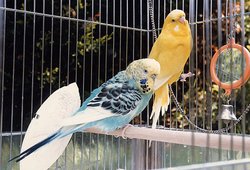Budgerigar
|
|
| Budgerigar | ||||||||||||||
|---|---|---|---|---|---|---|---|---|---|---|---|---|---|---|
 | ||||||||||||||
| Scientific classification | ||||||||||||||
| ||||||||||||||
| Binomial name | ||||||||||||||
| Melopsittacus undulatus (Shaw, 1805) |
The Budgerigar (Melopsittacus undulatus) or "Budgie", is a small parrot (they are often called parakeets but "parakeet" refers to many small parrots with long flat tails) originating in Australia, where it occurs throughout the drier parts of the continent. It is 18 cm long and 26-29 g weight, and has a green body, blue tail, and yellow face; the wings have greenish-black flight feathers and black coverts with yellow fringes, this black-and-yellow feathering also on the upper mantle and nape. The legs are grey, with zygodactyl toes. The bill is pinkish-brown with a basal cere bluish in adult males, pinkish-brown in females and immatures. It is the only species in the genus Melopsittacus.
It occurs in a variety of open habitats, primarily in scrub, open woodland and grassland. Breeding can be at any time of the year following good rains which promote the growth of the grass and other plant seeds that comprise their diet. The nest is in a hole in a tree; the 4-7 eggs are incubated for 18 days, with the young fledging about 30 days after hatching. Outside of breeding, Budgerigars are highly nomadic, covering extensive areas in small to very large flocks, seeking areas with good food resources. The nomadism also includes an element of migratory behaviour, with the far north of the range occupied in winter (June-September), and the far south in summer (September-January). Populations in some areas have increased as a result of increased water availability at farm livestock watering facilities.
The word budgerigar comes from the Kamilaroi Aboriginal Australian name for the species, gijirrigaa. An urban legend claims the name means "good food" or "good to eat".
Budgerigars in captivity
Budgerigar_Norway_-01.JPG
The Budgerigar is a very common and familiar pet. It is believed to be the most common pet parrot in the world, and has been bred in captivity since the 1850s. Breeders have worked over the centuries to produce a wide range of colours and mutations, such as yellow, blue, white, violet, olive, albino and lutino, clearwing and spangled. Feather mutations can produce crests or overly long shaggy feathers known as "feather dusters". Modern show budgerigars are larger than their wild cousins, with excessively puffy head feathers, giving them an exaggerated look. In full show glory, the eyes and beak are almost totally obscured by feathers. This obscuring of the eyes diminishes their quality of life. Such birds are more very prone to genetic diseases because of inbreeding.
Budgerigars are relatively easy to care for, and can be taught to speak, whistle tunes, and play with their humans. They are as intelligent as many larger parrots, and thrive on the mental stimulation of toys and interaction with humans.
In captivity, they can survive anywhere from 4 to 15 years. There has even been a report on Burke's Backyard (an Australian TV show) that a budgerigar called Jeff has lived in captivity for 26 years. Their life span depends on the budgie's type (English budgies do not live as long as their cousins in Australia and America, due to years of inbreeding to change their size and features) and the individual bird's health (which is influenced by exercise and diet).
Buying
If you plan to buy a baby budgerigar, expect to pay about $10 (USD). If you would like a hand-fed baby (which is not always good because the bird does not have valuable interaction with others of its kind), expect to pay about $20. Finally, if you want to buy a grown, trained budgie, you will be paying from $100 to $200.
External links
- A detailed list of great budgie sites can be found at
- The Budgie Research Group (http://www.budgieresearch.com)
Me & My Budgie (http://www.budgies.org/info/colors/colorlist.html).
- Life Span of a Budgie (http://www.birds-online.de/allgemein/alter_en.htm)
- A True Ambassador: The Budgerigar (http://www.holisticbirds.com/HBN01/june/pages/budgie1.htm)
